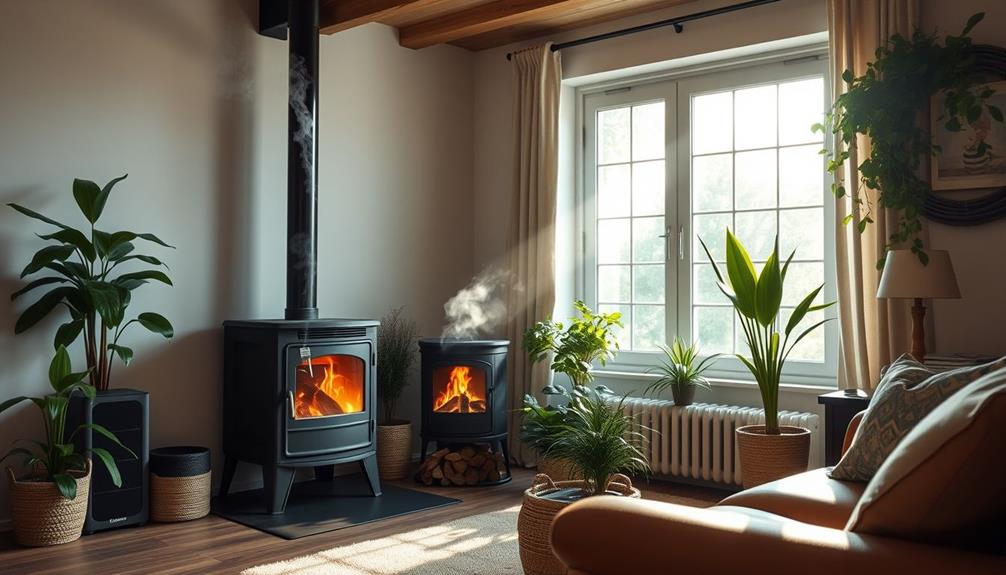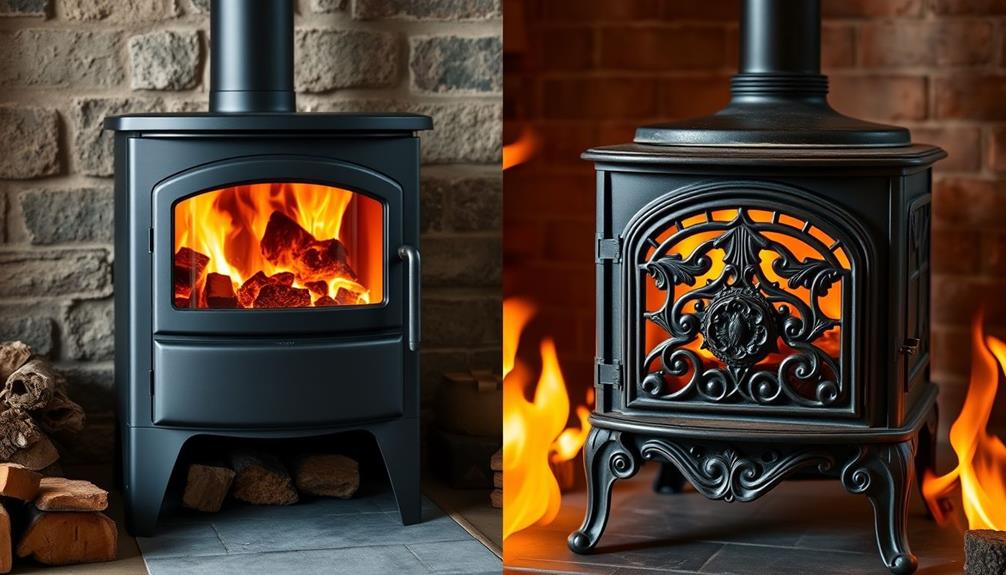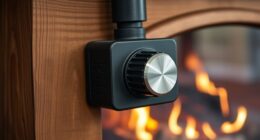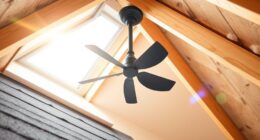Wood stoves can seriously affect your indoor air quality by emitting harmful pollutants like particulate matter and carbon monoxide. If you've got an older model, it's likely contributing more to poor air quality. To mitigate this, opt for EPA-certified stoves and burn seasoned wood to improve combustion efficiency. Regularly using air purifiers with HEPA filters can also help reduce harmful particles. Maintaining proper ventilation is essential for a healthier home environment. By taking these steps, you can protect your indoor air quality and safeguard your health. There are more practices and tips to explore that can enhance your home's air quality even further.
Key Takeaways
- Wood stoves produce harmful emissions, including PM2.5 and carbon monoxide, which negatively impact indoor air quality and health.
- Upgrading to EPA-certified, modern wood stoves can significantly reduce smoke emissions and improve combustion efficiency.
- Burning seasoned firewood (less than 20% moisture) enhances combustion and minimizes harmful particulate pollution.
- Regular use of air purifiers with HEPA filters can greatly reduce indoor air pollutants and improve air quality.
- Maintaining proper ventilation while using wood stoves is essential for minimizing indoor air pollution and ensuring a healthier environment.
Wood-Burning Emissions Overview
When it comes to wood-burning emissions, you might be surprised to learn just how substantial their impact can be on indoor air quality. Wood smoke is a major source of particulate pollution, releasing harmful emissions like carbon monoxide, nitrogen oxides, and volatile organic compounds. The emissions can vary depending on the type of stove used, with options like the Englander 10-Cpm Corn Wood Pellet Stove offering higher efficiency and lower emissions due to its high-efficiency rating.
These substances can drastically deteriorate the air you breathe inside your home. Incomplete combustion from burning wood produces fine particulate matter, such as PM10 and PM2.5, which are linked to serious health effects, including respiratory diseases and heart attacks.
Around 65% of wood stoves in the U.S. are older, inefficient models that contribute more to air pollution than newer, EPA-certified wood stoves. Burning wood also releases greenhouse gases like carbon dioxide and methane, worsening both indoor and outdoor air quality.
To mitigate these issues, it's crucial to adopt proper wood-burning practices. Using seasoned firewood and ensuring adequate ventilation can greatly reduce harmful wood-burning emissions. By making these adjustments, you can help improve your indoor air quality and protect your health while enjoying the warmth of a wood stove.
Health Risks of Wood Smoke
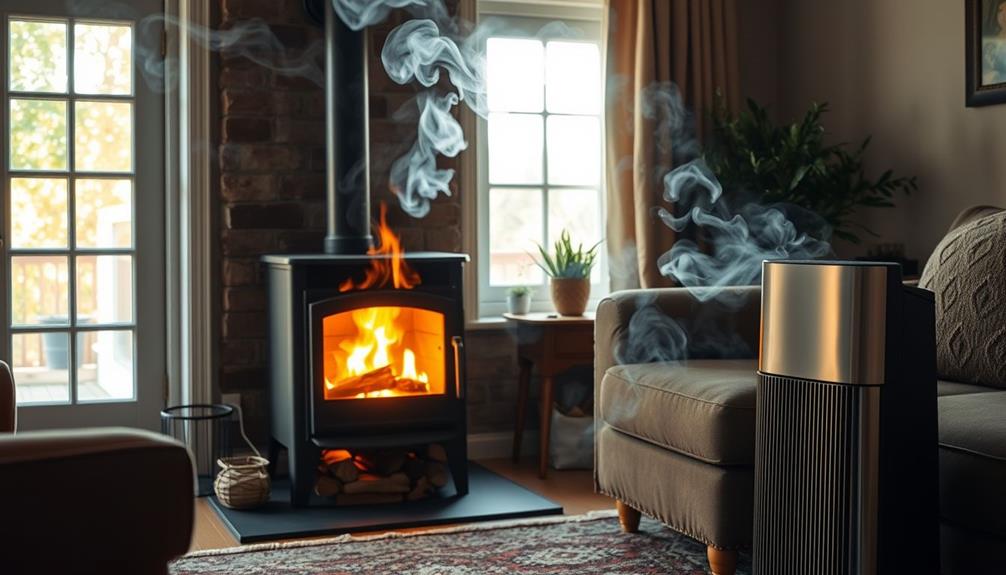
Wood smoke's harmful effects on your health can't be overlooked. When you burn wood indoors, you're not just creating warmth; you're also introducing a variety of pollutants into your indoor air. The inhalation of wood smoke can lead to serious respiratory issues, particularly for those with pre-existing conditions.
A holistic lifestyle approach, including stress management techniques, can help mitigate some of these risks. Here are some health risks associated with wood smoke exposure:
- Increased asthma attacks, especially in children and sensitive individuals.
- Development of chronic lung diseases due to long-term exposure to fine particulate matter (PM2.5).
- Greater risk of lung cancer and cardiovascular diseases.
- Heightened vulnerability in children and the elderly, whose respiratory systems are either developing or compromised.
Studies show that older wood stoves can produce indoor PM2.5 concentrations that exceed the EPA's standards, raising serious concerns about the air you breathe at home.
The tiny particles from wood smoke penetrate deep into the lungs, aggravating existing health issues and potentially leading to new ones. It's essential to understand these health risks so you can take proactive steps to protect yourself and your loved ones from the harmful effects of wood smoke.
Protecting Indoor Air Quality
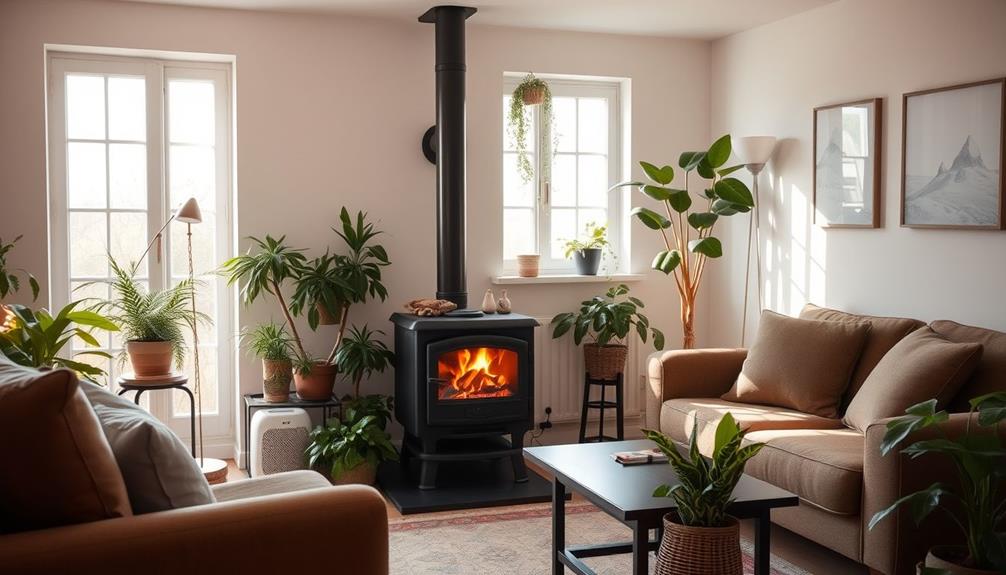
Indoor air quality can be greatly impacted by the use of wood stoves, but there are effective measures you can take to protect your living space.
First, consider limiting the use of wood-burning stoves to primary heat sources. This alone can considerably reduce indoor air pollution.
When you do use your wood stove, opt for EPA-certified models and burn seasoned wood, which contains less than 20% moisture. This choice enhances combustion efficiency and minimizes harmful emissions.
Additionally, incorporating ozone air purifiers can further eliminate allergens and odors, contributing to a healthier home environment.
Proper ventilation is also essential for maintaining healthier indoor environments.
Keep doors and windows closed during poor outdoor air quality days to prevent outdoor pollutants from entering.
Additionally, installing air purifiers equipped with HEPA and activated carbon filters can effectively reduce smoke pollutants, therefore improving your indoor air quality.
Alternatives to Wood Burning

Exploring alternatives to wood burning for home heating can lead to a healthier living environment and reduced indoor air pollution.
By considering cleaner options, such as geothermal energy basics, you can greatly improve indoor air quality while enjoying cozy warmth.
Here are some effective alternatives:
- Pellet Stoves: These stoves use compressed sawdust pellets and produce less smoke and harmful pollutants compared to traditional wood.
- Gas Stoves: Natural gas stoves generate lower particle pollution than wood-burning devices, providing a cleaner cooking and heating solution.
- Electric Heat Pumps: These systems can efficiently heat your home without emitting air pollution, making them an eco-friendly alternative.
- Solar Panels: Harnessing the sun's energy, solar panels can power electric heating systems, reducing reliance on wood and lowering greenhouse gas emissions.
Benefits of Stove Change-out Programs
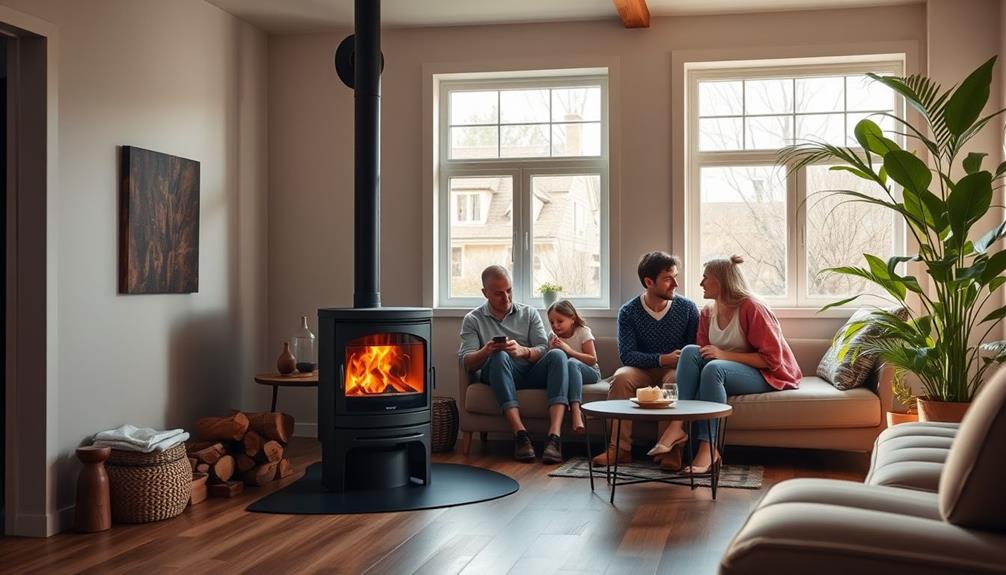
While many households rely on older wood stoves for heat, participating in stove change-out programs can greatly enhance your home's air quality and overall health. By replacing inefficient models, you can notably reduce harmful emissions. Upgrading to EPA-certified wood stoves not only improves indoor air quality but also decreases critical pollutants like particulate matter and carbon monoxide, which are essential for maintaining good respiratory health.
Here's how stove change-out programs benefit you and your community:
| Benefit | Description | Impact on Health |
|---|---|---|
| Reduced Harmful Emissions | Replacement of older stoves leads to lower smoke emissions. | Decreased respiratory issues. |
| Improved Indoor Air Quality | Cleaner-burning stoves improve air quality indoors. | Enhanced overall health. |
| Financial Assistance | Support for low-income families to access cleaner stoves. | Equitable health outcomes. |
| Community Pollution Reductions | Cleaner stoves benefit the broader community's air quality. | Better public health outcomes. |
Efficient Wood Heating Solutions
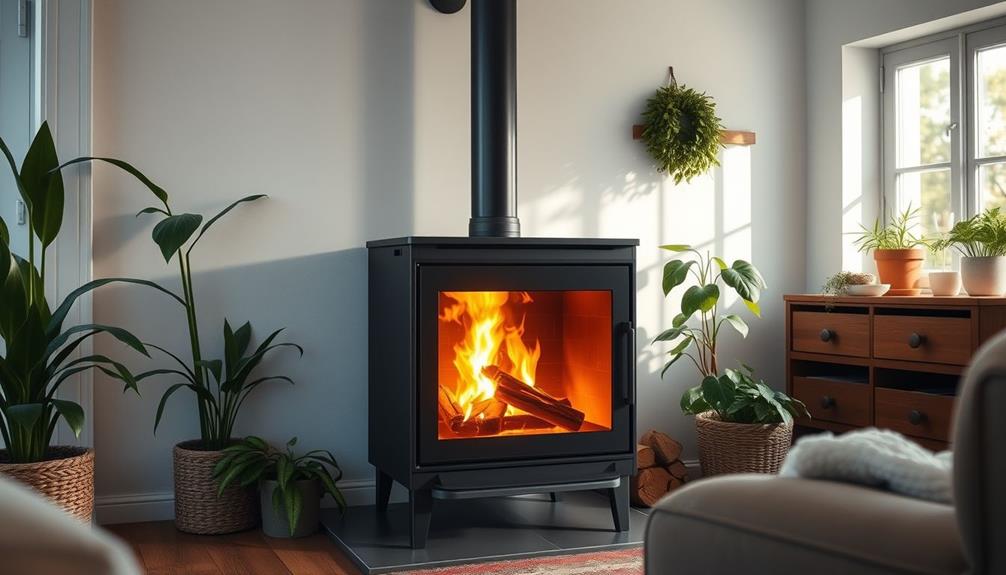
When you're considering wood heating solutions, opting for cleaner burning technologies can make a big difference in both efficiency and indoor air quality.
Modern stoves, especially EPA-certified models, not only burn fuel more effectively but also minimize harmful emissions.
Additionally, it's important to guarantee proper ventilation during use to maintain a safe and healthy environment, especially as gas appliances typically function without electricity.
Cleaner Burning Technologies
How can you enjoy the warmth of a wood stove without compromising indoor air quality? By embracing cleaner burning technologies, you can markedly improve the air in your home while still staying cozy.
For instance, incorporating enjoyable strategies in your home heating routine can enhance your overall experience, making it a fun challenge to maintain air quality while enjoying the warmth Fun in Goal Achievement.
Here's how:
- Upgrade to an EPA-certified wood stove: These models burn more cleanly and efficiently, reducing harmful emissions that threaten lung health compared to older stoves.
- Choose non-catalytic or catalytic stoves: Non-catalytic stoves use insulation for better combustion, while catalytic stoves employ a ceramic honeycomb to ignite smoke gases, resulting in lower particulate emissions.
- Opt for pellet stoves: These burn compressed biomass, offering high efficiency and producing fewer pollutants than traditional wood stoves, making them a cleaner alternative.
- Use seasoned firewood: Firewood with less than 20% moisture content not only enhances combustion efficiency but also helps reduce indoor smoke, leading to cleaner air.
Modern Stove Efficiency
Efficiency in wood heating has evolved considerably, offering homeowners cleaner and more sustainable options for warmth. Modern stoves, especially EPA-certified models, are designed to burn more efficiently, reducing smoke and particulate matter markedly. By upgrading to these stoves, you can cut emissions of harmful pollutants by up to 90%, enhancing your indoor air quality and decreasing health risks associated with wood smoke exposure.
Additionally, exploring the benefits of alternative investments can further support your financial health while making environmentally-conscious choices.
Efficient wood heating solutions, such as catalytic stoves and pellet stoves, utilize advanced combustion technology. This innovation leads to lower fuel consumption and reduced air pollution, creating a cleaner burning experience for you and your family.
To maximize efficiency, using seasoned firewood with less than 20% moisture content is essential. It promotes better combustion, resulting in fewer emissions and a more effective heating process.
Additionally, financial assistance programs are available to help households adapt to these cleaner, more efficient wood heating systems. By investing in modern stoves, you not only improve your home's air quality but also contribute to healthier communities.
Embracing these advancements in wood heating can make a considerable difference in your comfort and well-being.
Impact of Air Purifiers
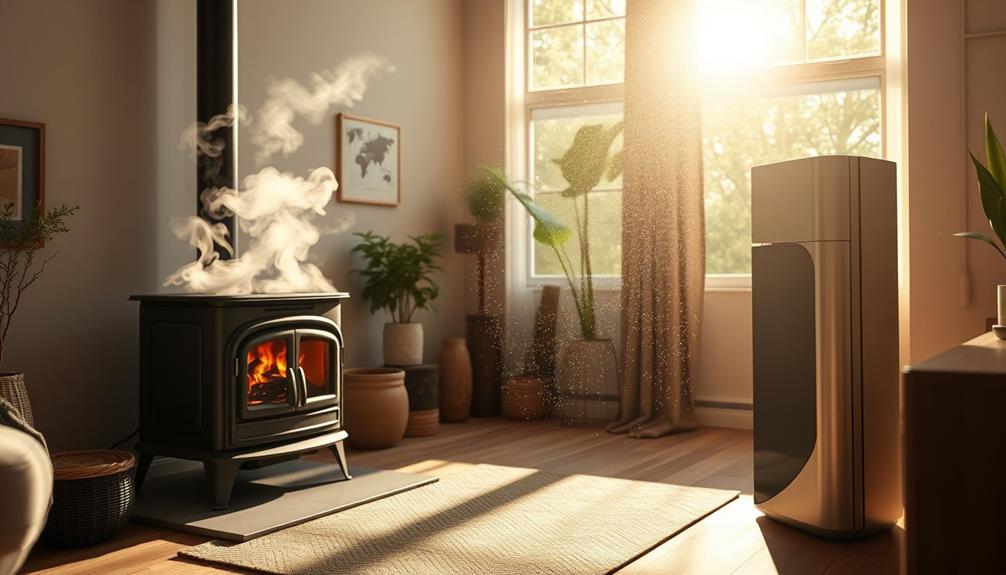
Air purifiers play an essential role in improving indoor air quality, especially in homes with wood stoves. They help mitigate the effects of indoor air pollutants, including PM2.5 from wood smoke.
Additionally, adopting a healthy lifestyle can enhance your overall well-being, making it easier to cope with environmental stressors. By using air purifiers equipped with HEPA and activated carbon filters, you can effectively reduce harmful emissions and enhance respiratory health.
Here are four key benefits of using air purifiers in your home:
- Reduction of PM2.5: Studies show air purifiers can achieve up to a 68% reduction in PM2.5 concentrations, considerably lowering wood smoke exposure.
- Removal of Volatile Organic Compounds (VOCs): Regular use helps eliminate harmful VOCs, which can be emitted during wood combustion.
- Enhanced Air Quality: Purifiers like TruSens® utilize multiple filtration systems, capturing smoke pollutants and improving overall air quality.
- Health Protection for Vulnerable Populations: Monitoring air quality and using air purification systems are crucial, especially for children, the elderly, or those with respiratory issues.
Incorporating air purifiers into your home can provide a healthier environment, particularly when utilizing wood stoves for heating.
Community Engagement Strategies

Improving indoor air quality goes beyond using air purifiers; community engagement plays an essential role in addressing the broader impacts of wood smoke. By fostering collaborative efforts, you can educate your neighbors about the health risks associated with wood smoke and encourage the adoption of cleaner burning practices.
Engaging in activities like organizing fun group events can help bring the community together and raise awareness in an enjoyable manner.
Organizing educational workshops is a great way to inform community members about the advantages of upgrading to EPA-certified wood stoves. These stoves notably reduce harmful emissions, leading to better indoor air quality.
Additionally, participating in local initiatives, such as wood stove change-out programs, can provide financial support to low-income families, helping them shift to more efficient heating options.
Establishing neighborhood coalitions focused on air quality empowers residents to advocate for better regulations and practices regarding wood burning. This shared responsibility fosters a culture of accountability in reducing air pollutants.
Lastly, consider initiating community-led air monitoring projects to raise awareness of pollution levels and their health impacts. Such actions can drive collective efforts toward adopting cleaner energy alternatives and improving indoor air quality standards in your community.
Together, you can make a meaningful difference in your local environment.
Monitoring Indoor Air Quality
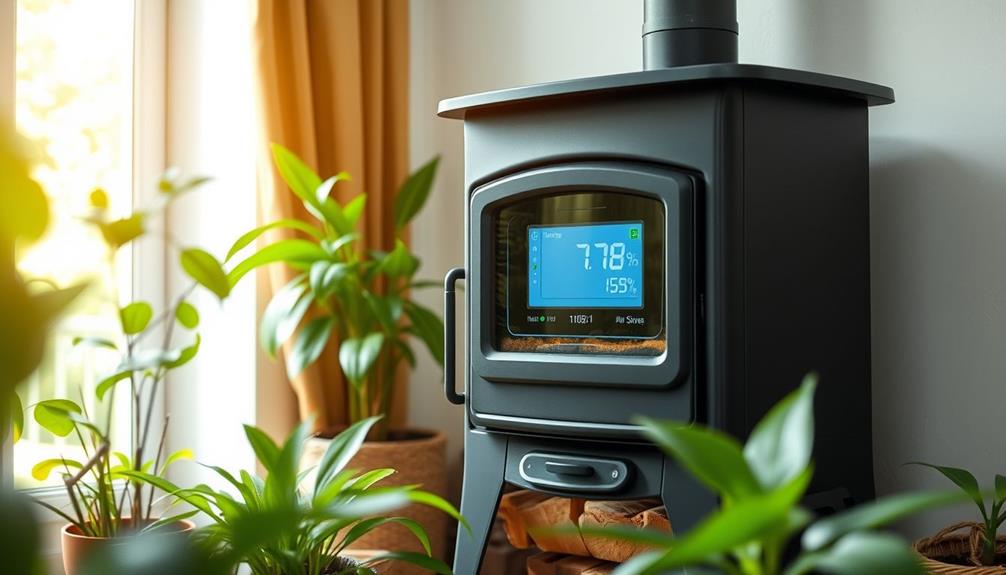
Monitoring indoor air quality (IAQ) is essential for homes with wood stoves, as they can experience elevated levels of harmful pollutants.
Many homes exceed safe PM2.5 levels, which can lead to considerable health risks like respiratory and cardiovascular issues. Understanding the potential emotional challenges associated with dealing with indoor pollutants is also important.
Regular assessments help you stay informed about the air you breathe and take necessary actions.
Here are four key steps to effectively monitor your IAQ:
- Use air quality monitors: Invest in devices that track PM2.5 and carbon monoxide levels to guarantee your home stays within safe limits.
- Engage in periodic assessments: Regular checks can help identify sources of wood smoke and inform you about necessary interventions.
- Implement air purification systems: Air filtration units can notably reduce PM2.5 concentrations, with some showing a 68% reduction in wood-burning homes.
- Consider cleaner-burning stoves: Upgrading to cleaner-burning options can further improve your indoor air quality and reduce harmful emissions.
Frequently Asked Questions
Do Wood Stoves Affect Indoor Air Quality?
Yes, wood stoves can affect indoor air quality. They release pollutants like particulate matter and carbon monoxide, which can lead to respiratory issues. Regular maintenance and using seasoned wood can help reduce these harmful emissions.
How to Reduce Pollution From Wood Burning Stoves?
You can embrace cleaner warmth by burning dry, seasoned wood and upgrading to EPA-certified stoves. Avoid hazardous materials, schedule regular maintenance, and consider air purifiers to enhance your indoor atmosphere while enjoying your wood stove.
How to Spread the Heat From a Wood Burning Stove Around the House?
To spread heat from your wood-burning stove, use ceiling fans to circulate warm air, keep doors open to other rooms, and consider a heat-powered stove fan for enhanced airflow throughout your home.
What's the Simplest Way to Mitigate an Indoor Air Quality Issue?
Think of your home as a garden; to keep it flourishing, you've got to manage the air. Limit pollutants by enhancing ventilation, using air purifiers, and maintaining clean, fresh spaces for everyone to breathe easier.
Conclusion
In summary, keeping your indoor air quality in check is essential for your health and well-being. By understanding the risks of wood smoke and exploring alternatives, you can breathe easier at home. Don't let smoke fill the air and compromise your comfort; it's time to take action. Whether it's upgrading your stove or using air purifiers, every little bit helps. Remember, a clean home is a happy home, so take the steps needed to safeguard your space.

